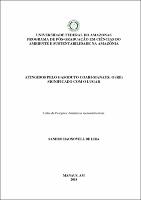| ???jsp.display-item.social.title??? |


|
Please use this identifier to cite or link to this item:
https://tede.ufam.edu.br/handle/tede/6460Full metadata record
| DC Field | Value | Language |
|---|---|---|
| dc.creator.Lattes | http://lattes.cnpq.br/0070062402670921 | por |
| dc.contributor.advisor1 | Fraxe, Therezinha de Jesus Pinto | - |
| dc.contributor.advisor1Lattes | http://lattes.cnpq.br/1464615574272190 | por |
| dc.date.issued | 2018-01-31 | - |
| dc.identifier.citation | LIRA, Sandro Haoxovell de. Atingidos pelo Gasoduto Coari-Manaus: o (re) significado com o lugar. 2018. 252 f. Tese (Doutorado em Ciências do Ambiente e Sustentabilidade na Amazônia) - Universidade Federal do Amazonas, Manaus, 2018. | por |
| dc.identifier.uri | https://tede.ufam.edu.br/handle/tede/6460 | - |
| dc.description.resumo | A exploração de recursos do petróleo na Província Petrolífera de Urucu ocorre numa das áreas consideradas como um dos últimos ―Eldorados‖ ambientais do mundo, a floresta amazônica. Assim, o município de Coari-AM, devido às demandas das atividades petrolíferas, vem sofrendo, desde a década de 1990, transformações ambientais significativas, sobretudo, as Comunidades Ribeirinhas de Várzea, situadas nas imediações do empreendimento estatal. Reconhece-se a relevância econômica do gasoduto Coari-Manaus para o país, entretanto, o ônus desse megaempreendimento tem recaído sobre as populações rurais, de modo a comprometer as possibilidades de reprodução da vida material e simbólica, sem que haja melhorias reais em sua qualidade de vida. O objetivo principal da pesquisa foi compreender, a partir da percepção dos Ribeirinhos de Várzea da Comunidade Esperança II, atingidos pelo Gasoduto Coari-Manaus, como eles mantêm ou (re) significam sua relação afetiva, existencial e de pertencimento com seus lugares. Para isto, foi necessário situar a exploração de hidrocarbonetos em Coari frente à modernidade líquida, e, também, realizar a descrição do modus vivendi dos ribeirinhos para, enfim, entender as transformações do habitus na percepção deles, as quais revelaram diversas paisagens do medo. Estas paisagens para os ribeirinhos representaram a introdução de dinâmicas socioambientais em suas vidas como jamais haviam vivenciado antes. Nesta tese empregou-se os métodos fenomenológico e o materialismo histórico-dialético, os quais serviram para dar sustentação à proposta de pesquisa. Usou-se também dois caminhos metodológicos: a etnografia e a percepção. Quanto às técnicas utilizou-se entrevistas semiestruturadas, formulários e levantamento iconográfico. Os resultados obtidos com a aplicação da metodologia proposta permitiram concluir que apesar dos impactos ambientais, os ribeirinhos estabelecem uma relação de afetividade profunda com a várzea e todos os habitats (terra, água e floresta), que não foram totalmente corrompidos pelas atividades de exploração de hidrocarbonetos. | por |
| dc.description.abstract | The exploration of oil resources at Urucu‘s Oil Province occurs in one of the last areas which can be called ―environmental Eldorado‖ in the world, the Amazon rainforest Thus, the municipality of Coari-AM, in face of the oil-drilling activities, has been suffering since the decade of 1990 major environmental transformations, especially the riverside inhabitants of the Amazonian wetlands communities, which are located in the surroundings of the Stateowned corporation. The economic relevance of the Coari-Manaus gas pipeline is for the whole country is acknowledged, however the onus of this huge enterprise has been taken the local rural populations, in ways to compromise the possibilities of reproduction of their material and symbolical way of living, without bring any kind of real improvement to their life quality. The primary purpose of this research was to comprehend, by the Comunidade Esperança II riverside wetland‘s inhabitants, which are affected by the Coari-Manaus gas pipeline, how do they keep or (re)define their affective, existential and belonging relationships with such places. To do so, it was necessary to situate the exploration of hydrocarbons in the municipality of Coari face to the liquid modernity, and also to describe the modus vivendi of the local riverside wetlands inhabitants to finally understand the transformations of the habitus in their perception, which have revealed so many fear sceneries. Those sceneries represent to the riverside wetlands inhabitants the introduction of social-environmental dynamics in their lives as they had never experienced before. In this thesis, we have employed the phenomenological method and also the historic-dialectical materialism, which both act to provide sustainability to our research proposal. The research has also used two methodological paths: ethnography and perception. About the techniques, were applied semi-structured interviews, forms and iconographic survey. The results that were obtained with the application of the proposed methodology permits to conclude that although the environmental impacts, the riverside wetlands inhabitants have stablished a deep affective relation with the wetlands and all kind of habitats (land, water and forest) that were not totally corrupted by the hydrocarbon exploration activities. | eng |
| dc.format | application/pdf | * |
| dc.thumbnail.url | https://tede.ufam.edu.br//retrieve/22433/Tese_Sandro%20de%20Lira.jpg | * |
| dc.language | por | por |
| dc.publisher | Universidade Federal do Amazonas | por |
| dc.publisher.department | Faculdade de Ciências Agrárias | por |
| dc.publisher.country | Brasil | por |
| dc.publisher.initials | UFAM | por |
| dc.publisher.program | Programa de Pós-graduação em Ciências do Ambiente e Sustentabilidade na Amazônia | por |
| dc.rights | Acesso Aberto | por |
| dc.rights.uri | http://creativecommons.org/licenses/by-nc-nd/4.0/ | - |
| dc.subject | Exploração de petróleo | por |
| dc.subject | Gás natural - Amazônia | por |
| dc.subject | Província Petrolífera de Urucu | por |
| dc.subject | Gasoduto Coari-Manaus | por |
| dc.subject.cnpq | CIÊNCIAS AGRÁRIAS | por |
| dc.title | Atingidos pelo Gasoduto Coari-Manaus: o (re) significado com o lugar | por |
| dc.type | Tese | por |
| Appears in Collections: | Doutorado em Ciências do Ambiente e Sustentabilidade na Amazônia | |
Files in This Item:
| File | Description | Size | Format | |
|---|---|---|---|---|
| Tese_Sandro de Lira | 3.03 MB | Adobe PDF |  Download/Open Preview |
This item is licensed under a Creative Commons License





